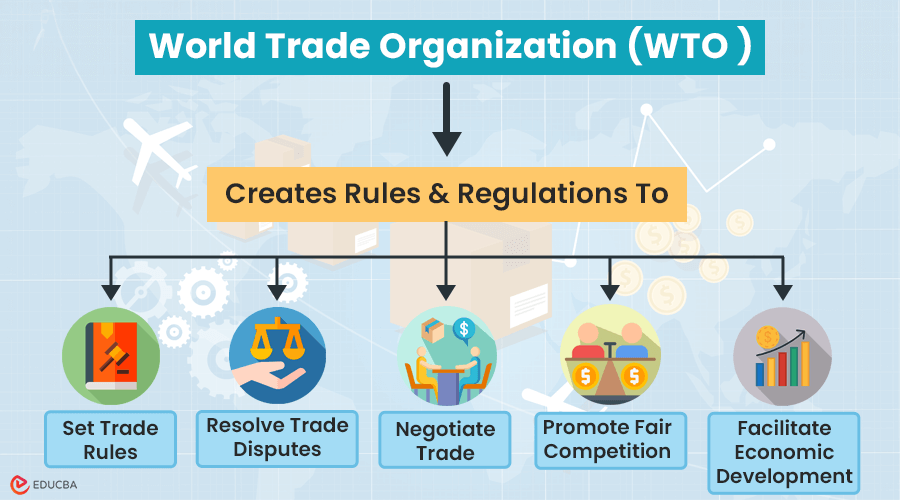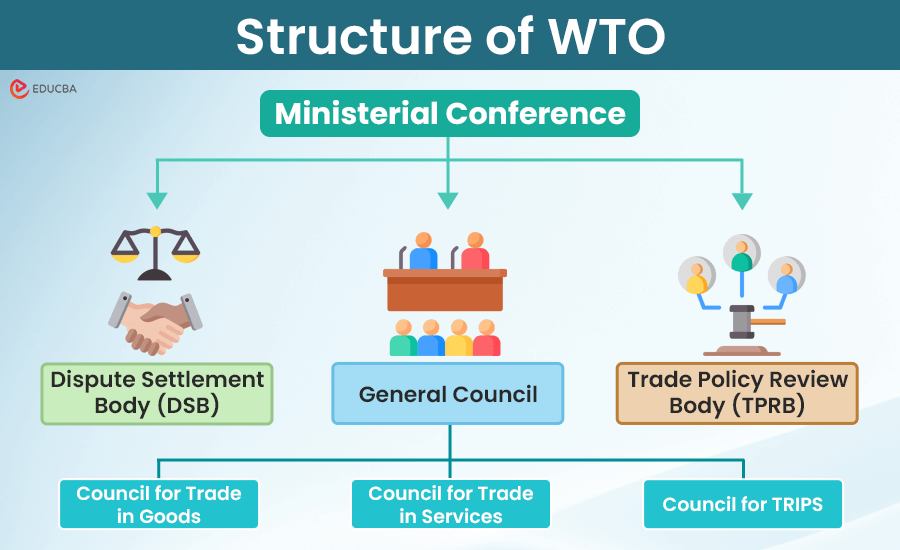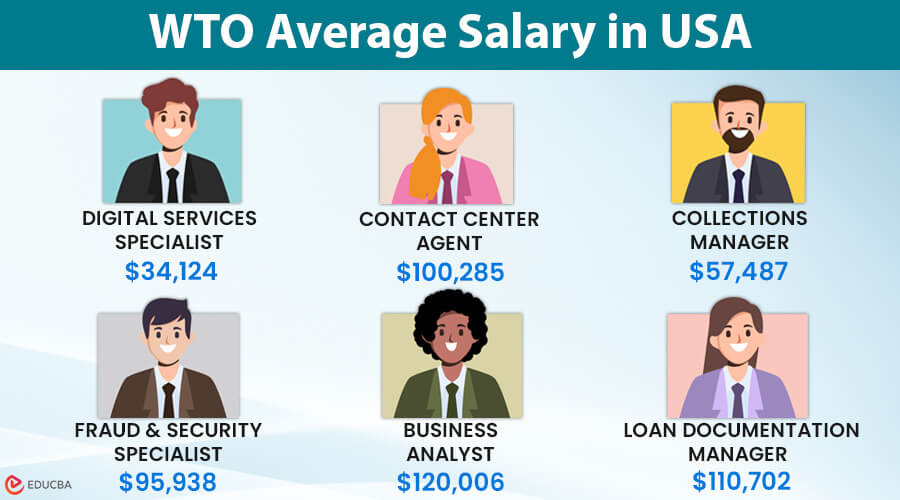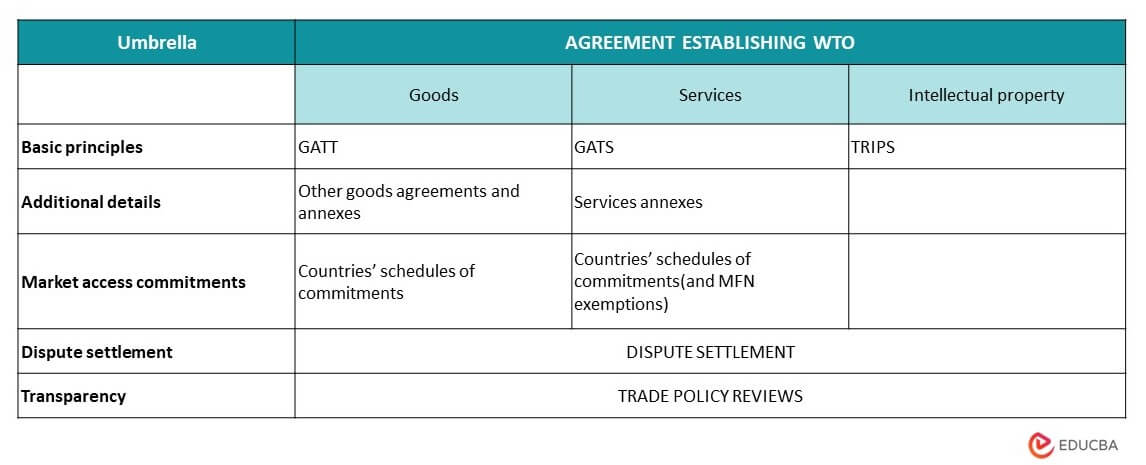
What is the World Trade Organization?
The World Trade Organization (WTO) is a firm with the power and authority to create rules of international trade (how nations should trade) as well as oversee if countries comply with these rules.
The WTO began on January 1, 1995, to replace the GATT (General Agreement on Tariffs and Trade), which began in 1948.
Table of Contents
- Definition
- Objectives
- Functions
- Members
- Structure
- Principles
- Salary
- Agreement
- Difference between GATT and WTO
- How to become a member?
- Benefits
Key Highlights
- It is an international organization made to create laws for international trade between different nations.
- It has 164 members across the world.
- The objective is to raise the standard of living and employment opportunities and improve people’s lives by increasing their sources of income.
- This organization’s benefits are that it ensures transparency and free and fair trade agreements.
Objectives of the World Trade Organization
The WTO aims to boost living standards and create jobs for its members by managing global trade rules. It supports developing countries in enhancing their trade abilities and serves as a platform for negotiating trade agreements and resolving disputes.
Its main objectives are:
- Setting and enforcing trade rules.
- Facilitating negotiations for more liberal trade.
- Resolving trade disputes.
- Increasing transparency in decision-making.
- Collaborating with other global economic institutions.
- Assisting developing countries in benefiting from global trade.
Functions of the World Trade Organization
The WTO serves several functions in the global economy:
1. Trade Negotiations
It helps negotiate trade agreements between member countries to decrease trade obstacles, such as tariffs and quotas, or to establish trade rules and guidelines.
2. Dispute Resolution
It allows member countries to settle disagreements about the understanding and implementation of trade agreements. The WTO’s Dispute Settlement Body (DSB) oversees this process.
3. Monitoring and Transparency
It monitors member countries’ trade policies and practices to ensure they follow WTO agreements to promote transparency and predictability in trade relations.
4. Trade Capacity Building
It offers training and support to developing countries so they can easily engage in global trade. It includes support for trade-related infrastructure, institutions, and policies.
5. Policy Review
It regularly reviews trade policies and practices through the Trade Policy Review Mechanism (TPRM). It allows member countries to discuss their trade policies and identify areas for improvement.
6. Promotion of Fair Competition
It promotes fair competition by prohibiting certain practices that distort competition, such as subsidies and dumping. It also provides rules for trade remedies, such as anti-dumping measures and countervailing duties.
7. Facilitating Economic Development
It contributes to economic development and prosperity by providing countries with a framework for trade and investment, which creates jobs and stimulates economic growth.
Members of the World Trade Organization
The WTO comprises 164 members and 25 observer governments (countries in the process of becoming members).
A. 164 members include:
| A | B | C |
| Afghanistan | Bahrain | Cabo Verde |
| Albania | Bangladesh | Cambodia |
| Angola | Barbados | Cameroon |
| Antigua and Barbuda | Belgium | Canada |
| Argentina | Belize | Central African Republic |
| Armenia | Benin | Chad |
| Australia | Bolivia | Chile |
| Austria | Botswana | China |
| D | Brazil | Colombia |
| Democratic Republic of the Congo | Brunei Darussalam | Congo |
| Denmark | Bulgaria | Costa Rica |
| Djibouti | Burkina Faso | Cote d’Ivoire |
| Dominica | Burundi | Croatia |
| Dominican Republic | F | Cuba |
| E | Fiji | Cyprus |
| Ecuador | Finland | Czech Republic |
| Egypt | France | G |
| El Salvador | I | Gabon |
| Estonia | Iceland | Gambia |
| Eswatini | India | Georgia |
| European Union | Indonesia | Germany |
| H | Ireland | Ghana |
| Haiti | Israel | Greece |
| Honduras | Italy | Grenada |
| Hong Kong, China | L | Guatemala |
| Hungary | Lao People’s Democratic Republic | Guinea |
| K | Latvia | Guinea-Bissau |
| Kazakhstan | Lesotho | Guyana |
| Kenya | Liberia | J |
| Korea | Liechtenstein | Jamaica |
| Kuwait | Lithuania | Japan |
| Kyrgyz Republic | Luxembourg | Jordan |
| M | N | O |
| Macao, China | Namibia | Oman |
| Madagascar | Nepal | P |
| Malawi | Netherlands | Pakistan |
| Malaysia | New Zealand | Panama |
| Maldives | Nicaragua | Papua New Guinea |
| Mali | Niger | Paraguay |
| Malta | Nigeria | Peru |
| Mauritania | North Macedonia | Philippines |
| Mauritius | Norway | Poland |
| Mexico | R | Portugal |
| Moldova, Republic of | Romania | S |
| Mongolia | Russian Federation | Saint Kitts and Nevis |
| Montenegro | Rwanda | Saint Lucia |
| Morocco | U | Saint Vincent and the Grenadines |
| Mozambique | Uganda | Samoa |
| Myanmar | Ukraine | Saudi Arabia |
| Q | United Arab Emirates | Senegal |
| Qatar | United Kingdom | Seychelles |
| T | United States | Sierra Leone |
| Chinese Taipei | Uruguay | Singapore |
| Tajikistan | V | Slovak Republic |
| Tanzania | Vanuatu | Slovenia |
| Thailand | Venezuela, the Bolivarian Republic of | Solomon Islands |
| Togo | Vietnam | South Africa |
| Tonga | Y | Spain |
| Trinidad and Tobago | Yemen | Sri Lanka |
| Tunisia | Z | Suriname |
| Turkiye | Zambia | Sweden |
| Zimbabwe | Switzerland |
B. 25 observer governments include:
| Observer Governments | ||
| Algeria | Curaçao | Sao Tomé and Principe |
| Andorra | Equatorial Guinea | Serbia |
| Azerbaijan | Ethiopia | Somalia |
| Bahamas | Holy See | South Sudan |
| Belarus | Iran | Sudan |
| Bhutan | Iraq | Syrian Arab Republic |
| Bosnia and Herzegovina | Lebanese Republic | Timor-Leste |
| Comoros | Libya | Turkmenistan |
| Uzbekistan | ||
Structure of WTO
The WTO structure comprises several key components:
1. Ministerial Conference
- Description: The highest decision-making body of the WTO.
- Composition: Comprises trade ministers from all member countries.
- Meetings: Held at least once every two years.
- Functions: Takes major decisions on multilateral trade agreements and sets the organization’s overall direction.
2. General Council
- Description: Oversees the day-to-day operations of the WTO.
- Composition: Representatives (usually ambassadors or heads of delegation) from all member countries.
- Meetings: Regularly throughout the year.
- Functions: Acts on behalf of the Ministerial Conference in the intervals between its meetings. It also meets as the Dispute Settlement Body and the Trade Policy Review Body.
3. Dispute Settlement Body (DSB)
- Description: Responsible for adjudicating trade disputes between member countries.
- Composition: Comprises all WTO members, represented by officials from member countries.
- Functions: Establish panels of experts to consider cases, adopt the panels’ and the Appellate Body’s reports, and monitor the implementation of the rulings and recommendations.
4. Trade Policy Review Body (TPRB)
- Description: Monitors national trade policies.
- Composition: Comprises all WTO members.
- Functions: Conducts periodic reviews of members’ trade policies and practices.
5. Council for Trade in Goods
- Description: Oversees the General Agreement on Tariffs and Trade (GATT) and related agreements.
- Composition: Open to all WTO members.
- Functions: Administers goods-related agreements and coordinates with related committees (e.g., agriculture, market access).
6. Council for Trade in Services
- Description: Oversees the General Agreement on Trade in Services (GATS).
- Composition: Open to all WTO members.
- Functions: Administers services-related agreements and coordinates with related committees (e.g., financial services, telecommunications).
7. Council for Trade-Related Aspects of Intellectual Property Rights (TRIPS)
- Description: Oversees the Agreement on Trade-Related Aspects of Intellectual Property Rights.
- Composition: Open to all WTO members.
- Functions: Administers the TRIPS Agreement, monitors its implementation, and reviews intellectual property rights issues.
Principles of WTO
1. Equal Treatment in Trade
This principle ensures equal treatment among trading partners. It includes:
- Most-Favored-Nation (MFN): Countries must treat all trading partners equally, granting one the same trade advantages as all others.
- National Treatment: Imported and locally-produced goods, services, and intellectual property should receive the same treatment once they enter the market.
2. Progressive Reduction of Trade Barriers
The system aims to gradually reduce trade barriers like tariffs and quotas through negotiation rounds. These negotiations have evolved to include non-tariff barriers, services, and intellectual property.
3. Stability and Transparency in Trade Policies
Stability and predictability in trade are crucial for investment and economic growth. Countries commit to binding their trade policies, which provides certainty to businesses. Transparency also emphasizes ensuring clear and public trade rules.
4. Establishment of Fair Competition
The WTO aims to establish fair conditions of trade through rules on non-discrimination, anti-dumping measures, and subsidies. The goal is to prevent unfair trade practices and support open competition.
5. Support for Development and Reform
While promoting free trade, the WTO recognizes the need for flexibility, particularly among developing countries. They provide special provisions and assistance to help them develop and adjust to WTO agreements.
WTO Salary in USA
Agreements of WTO
The WTO agreements include goods, services, and intellectual property, outlining liberalization principles and allowing exceptions.
The basic structure of the WTO agreements is as follows:
Difference Between GATT and WTO
| GATT | WTO | |
| Formation | Established in 1947. | Formed in 1995 after the Uruguay Round of negotiations. |
| Scope | Focused primarily on trade in goods. | Covers trade in goods, services, and intellectual property. |
| Legal Status | Provisional agreement. | A permanent international organization. |
| Decision Making | Depends on consensus among contracting parties. | Depends on consensus among the entire membership. |
| Dispute | Lacked a formal dispute settlement mechanism. | Includes a structured dispute settlement process. |
| Membership | Initially had 23 contracting parties. | Expanded to 164 members, i.e., 98% of world trade. |
How can a Country Become a Member of the WTO?
A country wishing to join the WTO must undergo a rigorous accession process. Below are the steps:
Step 1: Application and Introduction
Any independent state or customs territory can apply to join the WTO. To do so, they must provide detailed information about their trade and economic policies.
Step 2: Bilateral Negotiations
Once the WTO working party reviews the application, the applicant starts individual talks with existing WTO members. These discussions cover things like tariffs and market access. The new member’s commitments must apply equally to all WTO members.
Step 3: Membership Terms Drafting
After bilateral negotiations, the working party finalizes the terms of accession. It includes a report, a draft membership treaty, and a list of commitments.
Step 4: Decision and Approval
The WTO General Council or Ministerial Conference views the finalized package. If two-thirds of WTO members approve, the applicant can sign the protocol and become a member. Often, the applicant’s government must also ratify the agreement.
Benefits of the World Trade Organization
WTO membership offers several benefits:
- All companies from member countries have equal access to the markets of all other member countries.
- Domestic producers do not receive preferential treatment over importers from other member countries.
- Reduces tariffs and quantitative restrictions, promoting increased trade among member countries.
- Member countries bind their tariffs, providing predictability in international trade.
- Restrictions like bans or quotas are generally prohibited, ensuring transparency in trade regulations.
- Eliminates unfair trade practices like export subsidies and dumping, enhancing competitiveness among trading partners.
- Member countries can resolve trade disputes through the WTO Dispute Settlement Body, which ensures that it upholds international commitments and minimizes trade restrictions.
Final Thoughts
The World Trade Organization (WTO) is important for managing global trade and solving disputes between countries. Some see it as a way to boost the economy and keep trade fair. However, others think it is not doing enough to help developing countries or address new issues like environmental problems. It needs to change to stay effective and fair for everyone involved.
Frequently Asked Questions(FAQs)
Q1. What is the WTO’s dispute settlement mechanism?
Answer: The WTO’s dispute settlement mechanism provides a formal process for resolving trade disputes between members. This process involves consultations, panels, and, if necessary, an appellate review. They focus on resolving disputes with mutual agreement, but they can make binding decisions if necessary.
Q2. How does the WTO support developing countries?
Answer: The WTO provides technical assistance and capacity-building programs to help developing countries implement WTO agreements and enhance their ability to trade globally. Special provisions, known as “Special and Differential Treatment” (S&D), offer these countries more flexibility and additional time to meet their commitments.
Q3. What is the Doha Development Round?
Answer: The Doha Development Round is a series of trade negotiations launched in 2001. With revised trade rules and lower trade barriers, it aims to achieve major international trade system reforms. The round has faced significant challenges and has not concluded yet.
Q4. What is the relationship between the WTO and other international organizations?
Answer: The WTO collaborates with various international firms, like the World Bank, IMF, and the United Nations, to ensure coherence in global economic policy-making. This cooperation helps address issues that overlap between trade and other areas like finance, development, and the environment.
Recommended Articles
We hope this EDUCBA information on the WTO benefited you. For further guidance on economics-related topics, EDUCBA recommends these articles:




